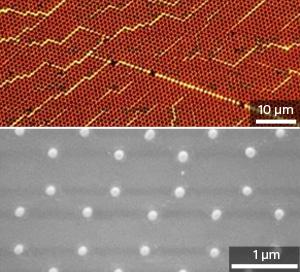Overcoming noise with light work

Dark-field microscopy (top) and scanning electron microscopy (bottom) images showing an array of plasmonic nanoparticles used as a highly sensitive sensor. Copyright : Reproduced from Ref. 1 and licensed under CC BY 3.0 ©2014 Kalashnikov et al.
As the sensitivity of plasmonic sensors reaches new heights, so does the challenge of using tiny sample volumes. Dmitry Kalashnikov and co-workers at the A*STAR Data Storage Institute in Singapore have devised an innovative way to improve sensor accuracy by exploiting the unique properties of quantum optics.
Some new sensors based on plasmonic nanostructures can detect responses from samples that contain only about 100,000 molecules. While increased sensitivity is a boon, the low volumes of the sample mean that the light used to probe such tiny amounts can induce unwanted changes in them.
Therefore, it is necessary to probe samples using very low light levels — even down to the ultimate limit of single photons. However, conventional techniques cannot cope with such small amounts of light: the signal strength from a sample becomes low compared with the background noise, rendering accurate detection impossible.
To address this problem, Kalashnikov and his team created a pair of ‘frequency-entangled’ photons by passing laser light through a nonlinear crystal. The frequencies of these two photons add up to that of the photon that initially hit the crystal. Thus, by measuring the frequency of one photon, the researchers could easily calculate the frequency of the other one.
To set up the measurement system, the researchers sent one of the photons to a plasmonic sensor — a hexagonal array of gold nanoparticles — and detected it with a highly sensitive light detector (see image), while using a spectrometer to measure the frequency of the other photon. By measuring the number of photon pairs that are simultaneously spotted by the two light detectors, they could determine the dependence of the transmittance of the sensor on the frequency.
To investigate the robustness of the measurements to background noise, the researchers then artificially introduced noise to the measurement of the photon that passed through the spectrometer. With this, they found that their technique could detect a tiny change in the refractive index (approximately 1 per cent) of a liquid sample placed immediately in front of the plasmonic sensor — even in the presence of severe noise up to 70 times stronger than the signal. When they performed the same measurement using conventional spectroscopy, they found that the noise completely swamped the signal.
“The trick is that both photons reach the detectors at the same moment, whereas noise is completely random, making it highly unlikely to cause both detectors to fire simultaneously,” Dmitry explains.
The extremely low photon levels of the technique make it suitable for measuring photosensitive compounds and ultralow concentrations of other substances.
Reference:
Kalashnikov, D. A., Pan, Z. Kuznetsov, A. I. & Krivitsky, L. A. Quantum spectroscopy of plasmonic nanostructures. Physical Review X 4, 011049 (2014). | article
Associated links
Media Contact
More Information:
http://www.researchsea.comAll latest news from the category: Physics and Astronomy
This area deals with the fundamental laws and building blocks of nature and how they interact, the properties and the behavior of matter, and research into space and time and their structures.
innovations-report provides in-depth reports and articles on subjects such as astrophysics, laser technologies, nuclear, quantum, particle and solid-state physics, nanotechnologies, planetary research and findings (Mars, Venus) and developments related to the Hubble Telescope.
Newest articles

Silicon Carbide Innovation Alliance to drive industrial-scale semiconductor work
Known for its ability to withstand extreme environments and high voltages, silicon carbide (SiC) is a semiconducting material made up of silicon and carbon atoms arranged into crystals that is…

New SPECT/CT technique shows impressive biomarker identification
…offers increased access for prostate cancer patients. A novel SPECT/CT acquisition method can accurately detect radiopharmaceutical biodistribution in a convenient manner for prostate cancer patients, opening the door for more…

How 3D printers can give robots a soft touch
Soft skin coverings and touch sensors have emerged as a promising feature for robots that are both safer and more intuitive for human interaction, but they are expensive and difficult…





















